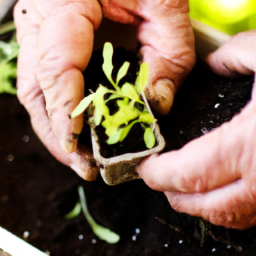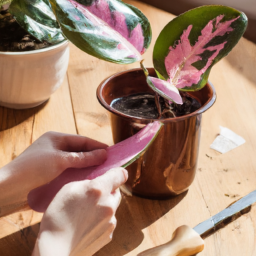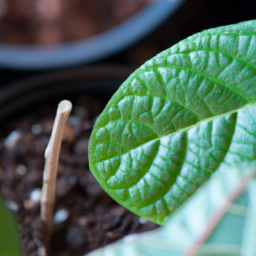
Welcome to our blog post on “Propagation by Leaf Cuttings: Unlocking New Plant Possibilities.” If you’re a plant enthusiast looking to expand your collection or a gardening enthusiast eager to explore new propagation techniques, you’ve come to the right place. In this article, we will delve into the fascinating world of propagation by leaf cuttings and discover the endless possibilities it offers for growing new plants. Whether you’re a seasoned gardener or a beginner, this technique will open up a whole new world of plant propagation and allow you to unlock the potential of various species. So, let’s dive in and explore the wonders of propagation by leaf cuttings together.
Benefits of Propagation by Leaf Cuttings in Plant Propagation
Introduction
Propagation by leaf cuttings is a fascinating technique that unlocks new possibilities in plant propagation. It involves taking a leaf from a parent plant and encouraging it to develop roots and grow into a new plant. This method offers several advantages over traditional propagation techniques, making it a popular choice among gardeners and horticulturists. In this article, we will explore the benefits of propagation by leaf cuttings and provide you with a step-by-step guide to unlock the potential of this innovative technique.
Enhanced Genetic Traits
One of the key benefits of propagation by leaf cuttings is the ability to preserve and propagate specific genetic traits of a plant. This technique allows gardeners to replicate plants with desirable characteristics, such as unique leaf shapes, vibrant flower colors, or disease resistance. By selecting leaves from parent plants with these desired traits, you can ensure that the new plants inherit these characteristics, creating a more diverse and visually appealing garden.
Cost-Effective and Efficient
Propagation by leaf cuttings is a cost-effective and efficient method of plant propagation. Unlike traditional methods like seed sowing or stem cuttings, leaf cuttings require minimal resources and can be done with readily available materials. Additionally, a single leaf can generate multiple new plants, maximizing the potential of your existing plant collection. This technique also saves time, as leaf cuttings generally root faster compared to other propagation methods, allowing you to enjoy new plants sooner.
Increased Plant Stock
Another advantage of propagation by leaf cuttings is the ability to rapidly increase your plant stock. With traditional methods, it can take years for a plant to reach maturity and produce seeds or stems suitable for propagation. However, with leaf cuttings, you can generate new plants within a matter of weeks or months, depending on the species. This accelerated growth rate enables you to expand your plant collection more quickly, experiment with new varieties, and share plants with friends and fellow gardeners.
Adaptability to Various Plant Species
Propagation by leaf cuttings is a versatile technique that can be applied to a wide range of plant species. From succulents and tropical plants to herbs and flowering perennials, many plants can be successfully propagated using this method. This adaptability allows you to explore a diverse array of plants and experiment with different propagation techniques, expanding your gardening horizons and introducing new species to your garden.
Conclusion
Propagation by leaf cuttings offers numerous benefits in plant propagation, making it an attractive option for gardeners and horticulturists. This technique allows for the preservation and propagation of specific genetic traits, providing a means to enhance the diversity and beauty of your garden. It is a cost-effective and efficient method that enables rapid plant multiplication, allowing you to expand your collection and share plants with others. Furthermore, the adaptability of leaf cuttings to various plant species opens up a world of possibilities for experimentation and exploration. So why not unlock the new plant possibilities with propagation by leaf cuttings and take your gardening to the next level?
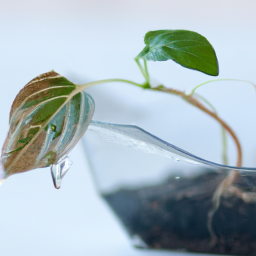
Step-by-Step Guide to Propagation by Leaf Cuttings
Introduction
Propagation by leaf cuttings is an exciting and rewarding method to unlock new plant possibilities. This technique allows you to create new plants from a single leaf, giving you the opportunity to expand your garden or share your favorite plants with friends and family. In this step-by-step guide, we will explore the process of leaf cutting propagation and provide you with all the necessary information to successfully propagate your plants.
1. Selecting the Right Leaf
To begin the propagation process, it is crucial to select the right leaf for cutting. Choose a healthy leaf from a mature and disease-free plant. Look for leaves that are fully developed, free from any signs of damage or disease, and have a vibrant color. It is also important to ensure that the leaf has a petiole or stem attached to it, as this will aid in the rooting process.
Once you have identified the perfect leaf, gently remove it from the plant using a sharp, sterilized knife or scissors. Make a clean cut close to the base of the leaf, ensuring that you retain a small portion of the petiole.
2. Preparing the Cutting
After selecting the leaf, it is time to prepare the cutting for propagation. Start by removing any excess foliage from the petiole, leaving only a few small leaves at the top. This will help reduce water loss and direct the plant’s energy towards root development.
Next, dip the cut end of the petiole into a rooting hormone powder or gel. Rooting hormones contain growth-promoting substances that stimulate the development of roots, increasing the success rate of propagation. Be sure to follow the instructions provided with the rooting hormone for the correct application method and dosage.
3. Creating the Ideal Growing Environment
Creating the ideal growing environment is crucial for successful leaf cutting propagation. Start by selecting a suitable planting medium. A well-draining mixture of peat moss, perlite, and vermiculite is commonly used for leaf cuttings. Fill a small container or tray with the planting medium, ensuring it is moist but not waterlogged.
Make small holes in the planting medium using a pencil or similar tool. These holes will serve as the planting sites for your leaf cuttings. Gently insert the cut end of the petiole into the hole, ensuring that the leaf remains above the surface of the medium.
4. Providing Adequate Care
Once the leaf cuttings are planted, it is important to provide them with adequate care to encourage root development and overall growth. Place the container or tray in a warm and well-lit area, preferably with indirect sunlight. Avoid placing the cuttings in direct sunlight, as this can cause excessive drying and damage to the delicate leaves.
Maintain a consistent level of moisture in the planting medium by misting it regularly or covering the container with a plastic dome or bag to create a mini greenhouse effect. This will help retain moisture and create a humid environment, which is essential for root development.
5. Patience and Monitoring
Propagation by leaf cuttings requires patience, as it can take several weeks or even months for the cuttings to develop roots and establish themselves as new plants. During this time, it is important to monitor the cuttings regularly for signs of growth and health.
Keep an eye out for new leaf growth or the emergence of roots from the cut end of the petiole. This indicates that the cuttings have successfully rooted and are ready for transplantation into individual pots or the garden.
Conclusion
Propagation by leaf cuttings is a fascinating and accessible method that allows you to unlock new plant possibilities. By following this step-by-step guide, you can successfully propagate your favorite plants and expand your garden with ease. Remember to select the right leaf, prepare the cutting properly, create an ideal growing environment, provide adequate care, and be patient throughout the process. With time and attention, you will be rewarded with a thriving collection of plants that started from a single leaf. Happy propagating!
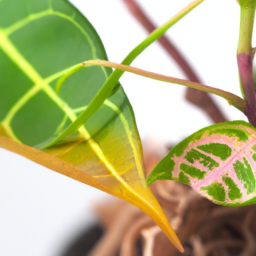
Common Plants Suitable for Propagation by Leaf Cuttings
Propagation by leaf cuttings is a fascinating and rewarding method to unlock new plant possibilities. It allows you to create new plants from a single leaf, expanding your garden or indoor plant collection with ease. In this guide, we will explore some common plants that are suitable for propagation by leaf cuttings, providing you with a step-by-step process to successfully propagate them.
1. Succulents
Succulents are known for their ability to store water in their leaves, making them excellent candidates for leaf propagation. Some popular succulents that can be propagated through leaf cuttings include Echeveria, Sedum, and Crassula. Here’s how you can propagate succulents through leaf cuttings:
1. Select a healthy leaf from the parent plant. Make sure it is fully grown and free from any damage or disease.
2. Gently twist or cut the leaf from the stem, ensuring that a small portion of the stem is attached to the base of the leaf.
3. Allow the leaf cutting to dry for a few days until a callus forms on the cut end. This helps prevent rotting during the propagation process.
4. Prepare a well-draining soil mix suitable for succulents. You can use a combination of potting soil, perlite, and sand.
5. Place the leaf cutting on top of the soil mix, ensuring that the base of the leaf is in contact with the soil.
6. Mist the soil lightly to provide moisture without overwatering. Keep the soil slightly moist but not soggy.
7. Place the leaf cutting in a bright, indirect light location. Avoid direct sunlight as it can scorch the delicate leaf.
8. After a few weeks, you will notice tiny roots emerging from the base of the leaf. This indicates successful propagation.
9. Once the new plant has established roots, you can gently transplant it into a separate container with well-draining soil.
Remember to be patient during the propagation process, as succulents can take some time to develop roots and grow into new plants.
2. African Violets
African violets are beloved for their vibrant flowers and compact growth habit. They can be easily propagated through leaf cuttings, allowing you to create new plants and share them with fellow gardening enthusiasts. Here’s how you can propagate African violets through leaf cuttings:
1. Select a healthy leaf from the parent plant. Choose a mature leaf that is free from any signs of disease or damage.
2. Carefully cut the leaf from the stem, ensuring that you have a clean cut.
3. Fill a small container with a well-draining soil mix specifically formulated for African violets.
4. Insert the leaf cutting into the soil mix, burying the stem end about an inch into the soil.
5. Mist the soil lightly to provide moisture without saturating it. African violets prefer slightly moist soil.
6. Cover the container with a clear plastic bag or use a propagation dome to create a humid environment for the leaf cutting.
7. Place the container in a warm location with bright, indirect light. Avoid direct sunlight as it can scorch the delicate leaves.
8. After a few weeks, you will notice small plantlets emerging from the base of the leaf. These are new plants forming.
9. Once the plantlets have developed a few leaves and roots, you can carefully separate them from the parent leaf and transplant them into individual pots.
With proper care and attention, your propagated African violets will grow into beautiful, blooming plants.
3. Begonias
Begonias are known for their stunning foliage and variety of colors and patterns. Leaf propagation is an excellent way to expand your begonia collection and create new plants with unique characteristics. Here’s how you can propagate begonias through leaf cuttings:
1. Choose a healthy, mature leaf from the parent begonia plant. Avoid selecting leaves that are damaged or diseased.
2. Cut the leaf from the stem, ensuring that you have a clean cut.
3. Prepare a well-draining soil mix suitable for begonias. You can use a combination of potting soil, perlite, and peat moss.
4. Dip the cut end of the leaf in a rooting hormone powder to promote root development.
5. Insert the leaf cutting into the soil mix, burying the stem end about an inch into the soil.
6. Mist the soil lightly to provide moisture without overwatering. Begonias prefer slightly moist soil.
7. Place the container in a warm location with bright, indirect light. Avoid direct sunlight as it can scorch the delicate leaves.
8. After a few weeks, you will notice small plantlets emerging from the base of the leaf. These are new begonia plants forming.
9. Once the plantlets have developed a few leaves and roots, you can carefully separate them from the parent leaf and transplant them into individual pots.
Propagation by leaf cuttings opens up a world of possibilities for expanding your plant collection. Whether you choose succulents, African violets, begonias, or any other suitable plant, following these step-by-step guidelines will help you successfully propagate new plants and unlock the potential of leaf cuttings.
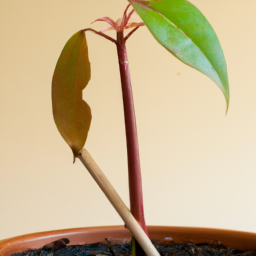
Propagation by Leaf Cuttings: Unlocking New Plant Possibilities
4. Tips and Tricks for Successful Propagation by Leaf Cuttings
Understanding Leaf Cuttings
Leaf cuttings are a popular method of plant propagation that can unlock new possibilities for expanding your garden. This technique involves taking a leaf from a parent plant and using it to grow a new plant. It is a simple and cost-effective way to increase your plant collection and share your favorite plants with others.
However, successful propagation by leaf cuttings requires careful attention to detail and a good understanding of the process. In this guide, we will provide you with tips and tricks to ensure successful propagation and help you unlock the potential of leaf cuttings.
Before we dive into the tips, let’s briefly discuss the two main types of leaf cuttings: whole leaf cuttings and leaf petiole cuttings.
1. Whole Leaf Cuttings
Whole leaf cuttings involve taking a leaf from a parent plant and encouraging it to root and develop into a new plant. This method is commonly used for plants with large leaves, such as African Violets and Begonias. Here’s how you can successfully propagate plants using whole leaf cuttings:
Step 1: Select a Healthy Leaf
Choose a mature and healthy leaf from the parent plant. Make sure the leaf is free from any signs of disease or damage.
Step 2: Prepare the Leaf
Using a clean, sharp knife or scissors, carefully cut the leaf from the parent plant. Make the cut just below the node, which is the point where the leaf attaches to the stem. Ensure that the leaf has a stem attached to it.
Step 3: Prepare the Potting Mix
Fill a small pot with a well-draining potting mix. Moisten the mix slightly, ensuring it is not too wet or too dry. Make a small hole in the potting mix using a pencil or your finger.
Step 4: Plant the Leaf
Insert the stem of the leaf into the hole you made in the potting mix. Gently press the mix around the base of the leaf to provide stability. Ensure that the leaf is upright and not touching the sides of the pot.
Step 5: Provide Proper Care
Place the pot in a warm and bright location, but avoid direct sunlight. Keep the potting mix consistently moist, but not waterlogged. Mist the leaf occasionally to maintain humidity. Within a few weeks, you should see new roots and eventually a new plant emerging from the base of the leaf.
2. Leaf Petiole Cuttings
Leaf petiole cuttings involve taking a leaf and a small portion of the stem (petiole) from a parent plant. This method is commonly used for plants with smaller leaves, such as Pothos and Philodendrons. Follow these steps to successfully propagate plants using leaf petiole cuttings:
Step 1: Select a Healthy Leaf
Choose a mature and healthy leaf from the parent plant. Look for a leaf with a long and healthy petiole.
Step 2: Prepare the Leaf
Using a clean, sharp knife or scissors, carefully cut the leaf and a small portion of the stem (petiole) from the parent plant. Make the cut just below the node, similar to whole leaf cuttings.
Step 3: Prepare the Potting Mix
Fill a small pot with a well-draining potting mix. Moisten the mix slightly, ensuring it is not too wet or too dry. Make a small hole in the potting mix using a pencil or your finger.
Step 4: Plant the Leaf Petiole
Insert the cut end of the petiole into the hole you made in the potting mix. Gently press the mix around the base of the petiole to provide stability. Ensure that the leaf is upright and not touching the sides of the pot.
Step 5: Provide Proper Care
Place the pot in a warm and bright location, but avoid direct sunlight. Keep the potting mix consistently moist, but not waterlogged. Mist the leaf occasionally to maintain humidity. In a few weeks, you should notice new roots developing from the base of the petiole, and eventually, a new plant will emerge.
Conclusion
Propagation by leaf cuttings is an exciting way to unlock new plant possibilities and expand your garden. Whether you choose to use whole leaf cuttings or leaf petiole cuttings, following these tips and tricks will increase your chances of success. Remember to select healthy leaves, provide proper care, and be patient as you wait for new roots and plants to develop.
With a little practice and experimentation, you’ll soon be propagating a wide range of plants and enjoying the satisfaction of growing your garden from leaf cuttings. Happy propagating!
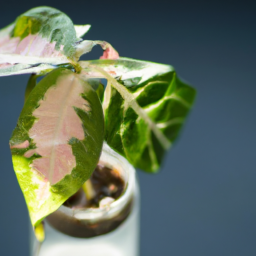
Exploring New Plant Varieties through Propagation by Leaf Cuttings
Propagation by leaf cuttings is a fascinating technique that allows plant enthusiasts to unlock new possibilities in their gardens. By carefully taking leaf cuttings from existing plants and providing them with the right conditions, you can propagate new plants that are genetically identical to the parent plant. This method not only offers a cost-effective way to expand your garden, but it also allows you to explore and discover new plant varieties. In this article, we will guide you through the step-by-step process of propagating plants through leaf cuttings, enabling you to unlock a world of exciting new plant possibilities.
Understanding Leaf Cuttings
Leaf cuttings involve taking a leaf from a parent plant and encouraging it to develop into a new plant. This method is particularly suitable for plants that have leaves with visible veins or petioles. The veins or petioles contain the necessary cells for root and shoot development. Some popular plants that can be propagated through leaf cuttings include African violets, begonias, and succulents.
To start the process, select a healthy leaf from the parent plant. It’s important to choose a leaf that is free from any diseases or damage. Using a clean, sharp knife or scissors, make a clean cut just below the node, which is the point where the leaf meets the stem. The node contains the cells necessary for root development.
Once you have your leaf cutting, remove any lower leaves or flowers, leaving only a small portion of the petiole intact. This will prevent excessive moisture loss and allow the cutting to focus its energy on root development. If the leaf is large, you can also cut it into smaller sections, making sure that each section has a node.
Preparing the Propagation Medium
Now that you have your leaf cuttings ready, it’s time to prepare the propagation medium. This is the material in which the cuttings will root and develop into new plants. There are several options for propagation mediums, including soil, perlite, vermiculite, or a mixture of these materials.
If you choose to use soil, make sure it is well-draining and sterile. A mixture of equal parts peat moss, perlite, and vermiculite is a popular choice for leaf cuttings. Fill a clean container with the propagation medium, leaving about an inch of space at the top to allow for watering.
Before inserting the leaf cuttings into the propagation medium, you can dip the cut ends in a rooting hormone powder. This will encourage faster root development. However, it is not necessary for all plant varieties, so make sure to research the specific needs of your chosen plant.
Planting and Caring for Leaf Cuttings
Now it’s time to plant your leaf cuttings in the prepared propagation medium. Make a small hole in the medium using a pencil or your finger and gently insert the cut end of the leaf cutting into the hole. Ensure that the node is covered with the propagation medium, as this is where the roots will emerge.
Once all the leaf cuttings are planted, lightly water the propagation medium to ensure it is evenly moist. Avoid overwatering, as excessive moisture can lead to rotting. Place the container in a warm location with bright, indirect light. Avoid direct sunlight, as it can scorch the delicate leaf cuttings.
Throughout the rooting process, it’s important to keep the propagation medium consistently moist. Check the moisture level regularly and water as needed. Mist the leaf cuttings with water to maintain humidity, especially in dry environments.
After a few weeks, you will start to see signs of root development. This is an exciting milestone, indicating that your leaf cuttings are successfully establishing themselves as new plants. Once the new plants have developed a sufficient root system, you can transplant them into individual pots with well-draining soil.
Caring for the newly propagated plants is similar to caring for mature plants. Provide them with adequate light, water, and nutrients, and monitor them for any signs of stress or disease. With time and proper care, your new plants will grow and thrive, allowing you to explore and enjoy new plant varieties in your garden.
Conclusion
Propagation by leaf cuttings offers a unique and rewarding way to explore new plant varieties. By following the step-by-step process outlined in this article, you can unlock a world of possibilities in your garden. Remember to select healthy leaves, prepare the right propagation medium, and provide the necessary care for your leaf cuttings. With patience and dedication, you can propagate new plants that are genetically identical to the parent plant, expanding your garden and discovering exciting new plant possibilities.
Key Takeaways of this article
In the world of gardening and plant propagation, leaf cuttings have long been overlooked as a viable method. However, recent studies and experiments have shown that propagating plants through leaf cuttings can unlock a whole new realm of possibilities. This technique involves taking a healthy leaf from a parent plant and encouraging it to sprout roots, eventually growing into a new plant.
One of the main advantages of propagating plants through leaf cuttings is the ability to create multiple new plants from just one parent plant. This can be especially useful for rare or hard-to-find plants, as it allows gardeners to expand their collection without having to rely on purchasing new plants. Additionally, leaf cuttings can be a great way to preserve and propagate special or sentimental plants, such as heirloom varieties or plants passed down through generations.
Furthermore, propagating plants through leaf cuttings can also be an exciting way to experiment and discover new plant varieties. By taking leaf cuttings from different plants and observing their growth patterns, gardeners can potentially create unique hybrids or uncover hidden traits that may not have been evident in the parent plant. This opens up a whole new world of possibilities for plant enthusiasts and can lead to the discovery of new and exciting plant varieties.
Your Questions Answered. Comprehensive FAQ:
Q1: What is propagation by leaf cuttings?
A1: Propagation by leaf cuttings is a method of reproducing plants by using a leaf or a portion of a leaf to grow a new plant. It involves taking a healthy leaf from a parent plant and encouraging it to develop roots and eventually grow into a new individual plant.
Q2: Which plants can be propagated by leaf cuttings?
A2: Many plants can be propagated successfully through leaf cuttings, including but not limited to succulents, certain herbs like mint and basil, African violets, begonias, and some houseplants like pothos and snake plants.
Q3: How do I take leaf cuttings for propagation?
A3: To take leaf cuttings, select a healthy leaf from the parent plant and make a clean cut just below the leaf node. Remove any lower leaves, leaving only a small portion attached to the stem. Place the cutting in a well-draining potting mix or water, and provide appropriate care to encourage root development.
Q4: What are the advantages of propagation by leaf cuttings?
A4: Propagation by leaf cuttings offers several advantages, such as the ability to create multiple new plants from a single parent plant, the potential for faster growth compared to other propagation methods, and the preservation of desirable traits from the parent plant.
Q5: How long does it take for leaf cuttings to root?
A5: The time it takes for leaf cuttings to root can vary depending on the plant species and environmental conditions. In general, it can take anywhere from a few weeks to several months for roots to develop. Patience and proper care are key during this process.
Q6: What care do leaf cuttings require during the rooting process?
A6: Leaf cuttings require a humid environment to promote root development. It is important to keep the cuttings moist but not overly wet, provide indirect light, and protect them from extreme temperatures. Regular misting and monitoring for any signs of disease or rot are also essential.
Q7: Can all leaf cuttings be successfully propagated?
A7: While many leaf cuttings can be successfully propagated, not all will root and grow into new plants. Some factors that can affect success include the plant species, the health and condition of the parent plant, and the care provided during the rooting process.
Q8: When is the best time to take leaf cuttings?
A8: The best time to take leaf cuttings can vary depending on the specific plant species. In general, it is often recommended to take leaf cuttings during the plant’s active growth period, which is typically in spring or early summer. However, some plants may have specific requirements, so it is advisable to research the particular species beforehand.
Q9: Can leaf cuttings be rooted directly in soil?
A9: Yes, leaf cuttings can be rooted directly in a well-draining potting mix or soil. It is important to ensure the soil is moist but not overly wet to prevent rot. Some plant species may benefit from rooting in a mixture of soil and perlite or vermiculite to improve drainage.
Q10: What should I do once the leaf cuttings have rooted?
A10: Once the leaf cuttings have rooted and developed a small plantlet, they can be carefully transplanted into individual pots or a suitable growing medium. Provide them with appropriate care, including regular watering, adequate light, and protection from extreme conditions, to promote healthy growth.
Dr. Olivia Green is a botanist with over two decades of experience in indoor plant cultivation. She holds a Ph.D. in Plant Biology and has dedicated her career to researching plant behavior in controlled environments. Dr. Green is passionate about helping plant enthusiasts master the art of indoor gardening through her extensive knowledge and practical insights.

